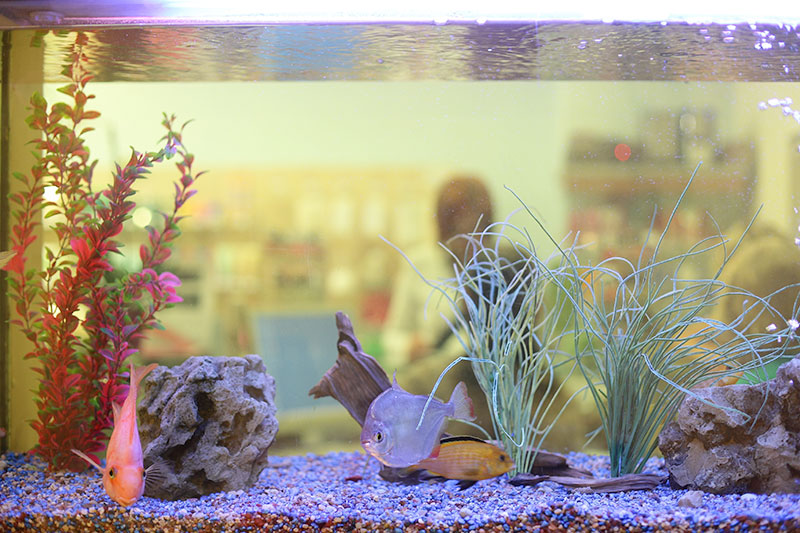
Setting up an aquarium is an exciting endeavor that allows you to create a beautiful underwater world in your home. To provide the best environment for your fish and ensure their well-being, it’s essential to choose the right aquarium. In this blog, we’ll explore tips to help you select the perfect aquarium for your fish, considering factors like size, shape, and essential equipment.
1. Assess the Space: Choosing the Right Location
Before selecting an aquarium, assess the space where you plan to keep it. Make sure the location can accommodate the size of the tank you have in mind. Ensure it’s away from direct sunlight, drafts, and heating or cooling vents, as these factors can stress the fish and affect water temperature.
2. Determine the Aquarium Size: Bigger is Usually Better
The size of your aquarium is a critical factor in ensuring your fish’s well-being. In general, a larger tank is better for fish as it provides more stability in terms of water quality, temperature, and oxygen levels. While smaller tanks can be suitable for certain fish species, beginners often find it easier to maintain a stable environment in a larger tank.
3. Consider the Shape: Traditional or Specialty?
Aquariums come in various shapes, from traditional rectangular or square tanks to specialty shapes like bow-front, hexagonal, or cylindrical tanks. Consider the aesthetic appeal and practicality of the shape, keeping in mind that traditional shapes provide more swimming space for fish.
4. Choose Between Glass and Acrylic: Material Matters
Aquariums are typically made of either glass or acrylic. Glass tanks are heavy and durable, while acrylic tanks are lighter, more impact-resistant, and can offer better visibility. Consider your preferences, as well as the specific requirements of your fish when selecting the tank material.
5. Research Your Fish Species: Habitat Needs
Different fish species have varying habitat needs. Some require a lot of space to swim, while others prefer more vertical space or specialized environments like reef tanks for corals and invertebrates. Research the specific requirements of your fish to ensure you choose an appropriate tank.
6. Check the Water Parameters: Freshwater or Saltwater?
Decide whether you want a freshwater or saltwater aquarium. Freshwater tanks are generally easier for beginners, while saltwater tanks can be more challenging but offer the opportunity to keep a wide variety of exotic fish and coral species. Ensure that you’re prepared to maintain the water parameters necessary for your chosen environment.
7. Consider the Equipment: Filters, Heaters, and Lighting
Your aquarium will require essential equipment, including filters to maintain water quality, heaters to regulate temperature, and lighting to support plant growth and showcase your fish. Choose reliable, energy-efficient equipment that suits the size and type of your tank.
8. Plan Your Aquascape: Plants and Decor
The aquascape, or the layout and decoration of your tank, is a creative aspect of setting up an aquarium. Consider adding live or artificial plants, substrate, and decorative elements that complement the needs and preferences of your fish. Make sure that the decor doesn’t overcrowd the tank, leaving enough swimming space.
9. Budget Wisely: Costs of Aquarium Ownership
Setting up and maintaining an aquarium involves costs beyond the initial purchase. Consider expenses like water conditioners, fish food, regular water testing kits, and potential veterinary care for your fish. Be prepared to budget for the long-term costs of aquarium ownership.
10. Maintenance and Cleaning: Time Commitment
Aquariums require regular maintenance and cleaning. Be realistic about the time you can commit to this aspect. Larger tanks generally require less frequent maintenance, but they can be more time-consuming when cleaning and water changes are necessary.
11. Research and Seek Advice: Consult with Experts
Don’t hesitate to seek advice from experts or join aquarium forums and communities. Knowledgeable individuals can provide valuable insights into tank selection, fish species compatibility, and maintenance. Doing your research and learning from experienced aquarists can save you from common pitfalls.
12. Start Slowly: A Beginner’s Approach
If you’re new to aquariums, consider starting with a smaller, simpler setup before moving on to larger, more complex systems. This can help you gain experience and confidence in aquarium care before taking on a more extensive project.
13. Compatibility and Fish Selection: Choose Wisely
When selecting fish for your aquarium, consider compatibility in terms of size, behavior, and water parameter requirements. Avoid overcrowding your tank, as it can lead to stress and health issues for the fish. Plan your fish selection carefully to ensure a harmonious aquatic community.
Choosing the perfect aquarium for your fish is a significant step in creating a thriving aquatic environment. By considering factors like size, shape, equipment, and the specific needs of your fish, you can ensure a successful and rewarding experience as an aquarium owner. Remember that proper research, preparation, and ongoing maintenance are crucial to keeping your underwater companions healthy and happy in their new home.





